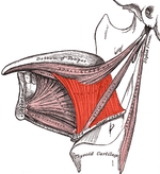
Hyoglossus
Encyclopedia
The Hyoglossus, thin and quadrilateral, arises from the side of the body and from the whole length of the greater cornu of the hyoid bone
, and passes almost vertically upward to enter the side of the tongue, between the Styloglossus
and Longitudinalis inferior.
The hyoglossus depresses and retracts the tongue makes the dorsum more convex
The fibers arising from the body of the hyoid bone overlap those from the greater cornu
.
It is important in singing
.
Structures passing medially to the hyoglossus muscle are the lingual vein and lingual artery. Laterally, in between the hyoglossus muscle and the mylohyoid muscle lay several important structures (from superior in inferior): sublingual gland
, submandibular duct, lingual nerve
, vena comitans
of hypoglossal nerve, and the hypoglossal nerve
. Note, posteriorly, the lingual nerve
is superior to the submandibular duct and a portion of the submandibular salivary gland protrudes into the space between the hyoglossus and mylohyoid muscles.
Hyoid bone
The hyoid bone is a horseshoe-shaped bone situated in the anterior midline of the neck between the chin and the thyroid cartilage. At rest, it lies at the level of the base of the mandible in the front and the third cervical vertebra behind.Unlike other bones, the hyoid is only distantly...
, and passes almost vertically upward to enter the side of the tongue, between the Styloglossus
Styloglossus
The Styloglossus, the shortest and smallest of the three styloid muscles, arises from the anterior and lateral surfaces of the styloid process, near its apex, and from the stylomandibular ligament....
and Longitudinalis inferior.
The hyoglossus depresses and retracts the tongue makes the dorsum more convex
The fibers arising from the body of the hyoid bone overlap those from the greater cornu
Greater cornu
The greater cornua of the hyoid bone project backward from the lateral borders of the body; they are flattened from above downward and diminish in size from before backward; each ends in a tubercle to which is fixed the lateral hyothyroid ligament.The upper surface is rough close to its lateral...
.
It is important in singing
Singing
Singing is the act of producing musical sounds with the voice, and augments regular speech by the use of both tonality and rhythm. One who sings is called a singer or vocalist. Singers perform music known as songs that can be sung either with or without accompaniment by musical instruments...
.
Structures passing medially to the hyoglossus muscle are the lingual vein and lingual artery. Laterally, in between the hyoglossus muscle and the mylohyoid muscle lay several important structures (from superior in inferior): sublingual gland
Sublingual gland
The sublingual glands are salivary glands in the mouth.They lie anterior to the submandibular gland under the tongue, beneath the mucous membrane of the floor of the mouth.They are drained by 8-20 excretory ducts called the ducts of Rivinus....
, submandibular duct, lingual nerve
Lingual nerve
The lingual nerve is a branch of the mandibular nerve , itself a branch of the trigeminal nerve, which supplies sensory innervation to the tongue...
, vena comitans
Vena comitans
Vena comitans is Latin for accompanying vein. It refers to a vein that is usually paired, with both veins lying on the sides of an artery. They are found in close proximity to arteries so that the pulsations of the artery aid venous return. Because they are generally found in pairs, they are...
of hypoglossal nerve, and the hypoglossal nerve
Hypoglossal nerve
The hypoglossal nerve is the twelfth cranial nerve , leading to the tongue. The nerve arises from the hypoglossal nucleus and emerges from the medulla oblongata in the preolivary sulcus separating the olive and the pyramid. It then passes through the hypoglossal canal...
. Note, posteriorly, the lingual nerve
Lingual nerve
The lingual nerve is a branch of the mandibular nerve , itself a branch of the trigeminal nerve, which supplies sensory innervation to the tongue...
is superior to the submandibular duct and a portion of the submandibular salivary gland protrudes into the space between the hyoglossus and mylohyoid muscles.

